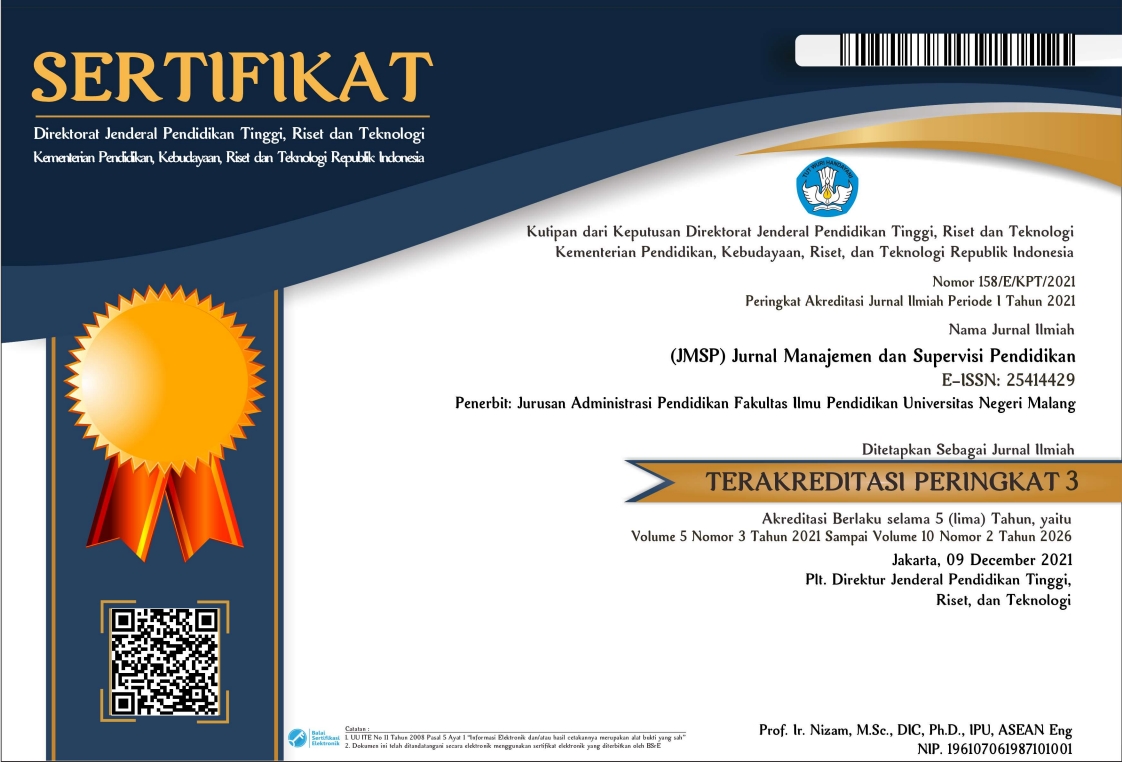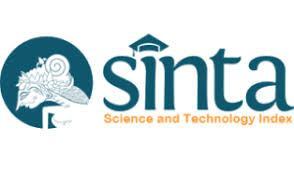Pengaruh Lembaga Pendidikan dan Penanggulangan Bencana Daerah terhadap Partisipasi Pelatihan Bencana Rumah Tangga
Abstract
Abstract: Disaster coping management is important to be well managed by the government and all stakeholders because Indonesia is a disaster-prone area. Disaster risk reduction (DRR) is needed because of the number of disasters occurring recently have serious impacts on the economy, social and environment. This study aims to look at the effect of education institution and regional disaster management institutions (BPBD) on household participation of disaster training as an effort of DRR. Literature also revealed that regional and households characteristics have an important role in implementing DRR.The design of this study uses quantitative logit regression analysis using secondary data from 297,276 household respondents from the 2017 National Socio-Economic Survey (SUSENAS). The results showed the disaster institutions at the district level, secondary education and universities has a significant impact and was able to provide an increase in probability of household disaster training participation.
Abstrak: Manajemen penanggulangan bencana merupakan hal yang penting dikelola dengan baik oleh pemerintah dan semua elemen masyarakat karena Indonesia memiliki wilayah rawan bencana. Pengurangan risiko bencana (PRB) diperlukan mengingat banyaknya kejadian bencana dewasa ini berdampak cukup serius pada perekonomian, sosial maupun lingkungan hidup. Penelitian ini bertujuan untuk melihat pengaruh lembaga pendidikan serta keberadaan lembaga penanggulangan bencana daerah terhadap partisipasi pelatihan atau simulasi bencana rumah tangga sebagai upaya PRB. Literatur juga mengungkapkan bahwa karakteristik daerah memiliki peran penting dalam implementasi PRB secara optimum. Desain penelitian ini menggunakan analisis kuantitatif regresi logit dengan memanfaatkan data sekunder 297,276 responden rumah tangga dari Survei Sosial Ekonomi Nasional (SUSENAS) tahun 2017. Hasil menunjukan keberadaan lembaga penanggulangan bencana kab/kota dan lembaga pendidikan di daerah berupa pendidikan menengah, perguruan tinggi memiliki pengaruh signifikan dan dapat memberikan peningkatan terhadap kemungkinan partisipasi pelatihan kebencanaan rumah tangga.
Keywords
Full Text:
PDFReferences
Ainuddin, S., Aldrich, D. P., Routray, J. K., Ainuddin, S., & Achkazai, A. (2013). The need for local involvement: Decentralization of disaster management institutions in Baluchistan, Pakistan. International Journal of Disaster Risk Reduction, 6, 50–58. https://doi.org/10.1016/j.ijdrr.2013.04.001
Amri, A. (2017). Pendidikan Tangguh Bencana: Mewujudkan Satuan Pendidikan Aman Bencana di Indonesia,
Bae, Y. (2015). Decentralization and collaborative disaster governance: Evidence from South Korea. Habitat International, 52, 50–56.
Baytiyeh, H. (2015). Developing effective earthquake risk reduction strategies: The potential role of academic institutions in Lebanon. Prospects, 45(2), 245–258. https://doi.org/10.1007/s11125-015-9344-3
Betty, P., Maida, C. A., Steinberg, A. M., Beaton, R. D., Pynoos, R. S., Fairbank, J. A., … Kurklinsky, A. K. (2010). Enhancing national capacity to conduct child and family disaster mental health research. Nursing Education Perspectives, 31(4), 237–241.
Bramasta, D., & Irawan, D. (2020). Mitigasi Bencana Gunung Meletus di Sekolah Rawan Bencana. Publikasi Pendidikan, 10(2)(24), 154–159.
Carter, W. (1983). Counter‐disaster training in developing countries. Disasters, 7(1), 34–36. https://doi.org/10.1111/j.1467-7717.1983.tb00785.x
Cashin, P., & Sosa, S. (2013). Macroeconomic fluctuations in the Eastern Caribbean: The role of climatic and external shocks. Journal of International Trade and Economic Development, 22(5), 729–748. https://doi.org/10.1080/09638199.2011.599854
Catangui, M. J. B. (2020). Customizing school-based disaster risk reduction and management capability. Journal of Critical Reviews, 7(11), 175–180. https://doi.org/10.31838/jcr.07.11.28
Chan, N. W., Roy, R., Lai, C. H., & Tan, M. L. (2019). Social capital as a vital resource in flood disaster recovery in Malaysia. International Journal of Water Resources Development, 35(4), 619–637.
Chang, S., Wang, J., Lei, Y., Yu, H., & Li, Q. (2012). Training programs for risk reduction of Typhoon disaster chains in Southeast coastal region of China. Proceedings of the 4th International Disaster and Risk Conference: Integrative Risk Management in a Changing World - Pathways to a Resilient Society, IDRC Davos 2012, 122–125.
Chen, C. Y., Yu, K. H., & Chen, M. Y. (2012). Planning of professional teacher-training program for disaster prevention education and executing efficiency evaluation. Disaster Prevention and Management: An International Journal, 21(5), 608–623.
Damayanti, S. N. (2017). Analisis Prospektif Kebijakan Pengalihan Kewenangan Pendidikan Menengah dari Pemerintah Kota Surabaya ke Pemerintah Provinsi Jawa Timur Berdasarkan UU No . 23 Tahun 2014 Tentang Pemerintahan Daerah. Kebijakan Dan Manajemen Publik, 5(3), 1–12.
Erdik, M. O., & Goyet, C. de V. de. (1991). Training and education for disaster preparedness. In The Challenge of African Disasters. UN. Institute for Training and Research (UNITAR).
Garschagen, M. (2016). Decentralizing urban disaster risk management in a centralized system? Agendas, actors and contentions in Vietnam. Habitat International, 52, 43–49. https://doi.org/10.1016/j.habitatint.2015.08.030
Hidayat, N. (2016). Otonomi Daerah Dan Desentralisasi (Studi Pada Jenjang Pendidikan Menengah Dinas Pendidikan Kota Sawahlunto). Society, 4, 35–50.
Hidayati, U. (2013). Hubungan Antara Persepsi Risiko Dengan Kesiapsiagaan Bencana Pada Mahasiswa Unsyiah. ETD Unsyiah.
Honesti, L., & Djali, N. (2012). Pendidikan Kebencanaan di Sekolah – Sekolah di Indonesia Berdasarkan Beberapa Sudut Pandang Disiplin Ilmu Pengetahuan. Jurnal Momentum, 12(1), 51–56.
Hosoya, K. (2016). Recovery from natural disaster: A numerical investigation based on the convergence approach. Economic Modelling, 55, 410–420.
Indriasari, F. N. (2018). Pengaruh Pemberian Metode Simulasi Siaga Bencana Gempa Bumi terhadap Kesiapsiagaan Anak di Yogyakarta. Jurnal Keperawatan Soedirman, 11(3), 199.
Kais, S. M., & Islam, M. S. (2016). Community capitals as community resilience to climate change: Conceptual connections. International Journal of Environmental Research and Public Health, 13(12). https://doi.org/10.3390/ijerph13121211
Kamil, P. A., Utaya, S., Utomo, D. H., Utaya, S., & Utomo, D. H. (2020). Improving disaster knowledge within high school students through geographic literacy. International Journal of Disaster Risk Reduction, 43.
Kawawaki, Y. (2015). Building resilient coastal communities: Role of social capital. In Ozhan E. (Ed.), 12th International Conference on the Mediterranean Coastal Environment, MEDCOAST 2015 Volume 1 (pp. 33–43). Mediterranean Coastal Foundation.
Kim, H., & Marcouiller, D. W. (2016). Natural Disaster Response, Community Resilience, and Economic Capacity: A Case Study of Coastal Florida. Society and Natural Resources, 29(8), 981–997. https://doi.org/10.1080/08941920.2015.1080336
Kirikkaya, E. B., Çakin, O., Imali, B., & Bozkurt, E. (2011). Earthquake training is gaining importance: The views of 4 th and 5 th year students on earthquake. Procedia - Social and Behavioral Sciences, 15, 2305–2313. https://doi.org/10.1016/j.sbspro.2011.04.098
Kusumasari, B., & Alam, Q. (2012). Bridging the gaps: The role of local government capability and the management of a natural disaster in Bantul, Indonesia. Natural Hazards, 60(2), 761–779. https://doi.org/10.1007/s11069-011-0016-1
Magnus, H., & Per, B. (2012). Seven elements for capacity development for disaster risk reduction. Proceedings of the 4th International Disaster and Risk Conference: Integrative Risk Management in a Changing World - Pathways to a Resilient Society, IDRC Davos 2012, 286–289.
Maknun, J. (2015). Pembelajaran Mitigasi Bencana Berorientasi Kearifan Lokal Pada Pembelajaran IPA Di Sekolah Menengah Kejuruan. Jurnal Kajian Pendidikan, 5(1), 143–156.
Malalgoda, C., Amaratunga, D., & Pathirage, C. (2010). Role of the local governments in disaster risk reduction. COBRA 2010: The Construction, Building and Real Estate Research Conference of the Royal Institution of Chartered Surveyors, 286–289.
Mukhlis, T., Syakur, T., Dharma, D. B., & Anhorn, J. (2017). School preparedness and training for geological hazard mitigation: An example from Indonesia. WIT Transactions on the Built Environment, 173, 113–119. https://doi.org/10.2495/DMAN170111
Narayan, P. K. (2003). Macroeconomic impact of natural disasters on a small island economy: Evidence from a CGE model. Applied Economics Letters, 10(11), 721–723. https://doi.org/10.1080/1350485032000133372
Nazara, S. (2010). Pemerataan Antardaerah sebagai Tantangan Utama Transformasi Struktural Pembangunan Ekonomi Indonesia Masa Depan. Jurnal Ekonomi Dan Pembangunan Indonesia, Vol. 11, pp. 83–98. https://doi.org/10.21002/jepi.v11i1.183
Nifa, F. A. A., Lin, C. K., Abbas, S. R., & Siong, E. S. (2018). A study of disaster and community risk knowledge among UUM students. AIP Conference Proceedings, 2016(September). https://doi.org/10.1063/1.5055408
Pahleviannur, M. R. (2019). Edukasi Sadar Bencana Melalui Sosialisasi Kebencanaan Sebagai Upaya Peningkatan Pengetahuan Siswa Terhadap Mitigasi Bencana. Jurnal Pendidikan Ilmu Sosial, 29(1), 49–55. https://doi.org/10.23917/jpis.v29i1.8203
Park, J. Y., Cho, J., & Rose, A. (2011). Modeling a major source of economic resilience to disasters: Recapturing lost production. Natural Hazards, 58(1), 163–182. https://doi.org/10.1007/s11069-010-9656-9
Pathirage, C., Seneviratne, K., Amaratunga, D., & Haigh, R. (2012). Managing disaster knowledge: Identification of knowledge factors and challenges. International Journal of Disaster Resilience in the Built Environment, 3(3), 237–252.
Priester, L. De. (2016). An approach to the profile of disaster risk of Indonesia. Emergency and Disaster Reports, 3(2), 66.
Scott, Z., Wooster, K., Few, R., Thomson, A., & Tarazona, M. (2016). Monitoring and evaluating disaster risk management capacity. Disaster Prevention and Management, 25(3), 412–422.
Setiawati, T. (2018). Program Penggabungan Sekolah Dasar (SD) Dalam Meningkatkan Efektivitas dan Efisiensi Penyelenggaraan Pendidikan. MENDIDIK: Jurnal Kajian Pendidikan Dan Pengajaran, 4(1), 55–62. https://doi.org/10.30653/003.201841.43
Suhardjo, D. (2011). Arti Penting Pendidikan Mitigasi Bencana Dalam Mengurangi Resiko Bencana. Jurnal Cakrawala Pendidikan, (2), 174–188.
Susanti, R., Sari, S. A., Milfayetty, S., & Dirhamsyah, M. (2014). Hubungan Kebijakan, Sarana dan Prasarana dengan Kesiapsiagaan Komunitas Sekolah Siaga Bencana Banda Aceh. Jurnal Ilmu Kebencanaan (JIKA), 1(1), 42–49.
Timothy, S. I. M., Dominelli, L., & Jocelyn, L. A. U. (2017). a Pathway To Initiate Bottom-Up Community-Based Disaster Risk Reduction Within a Top-Down System: the Case of China. International Journal of Safety and Security Engineering, 7(3), 283–293. https://doi.org/10.2495/SAFE-V7-N3-283-293
Trainor, J. E., & Velotti, L. (2013). Leadership in crises, disasters, and catastrophes. Journal of Leadership Studies, 7(3), 38–40. https://doi.org/10.1002/jls.21295
Walz, B. J. (1992). Disaster Training Exercises: An Educationally-Based Hierarchy. Prehospital and Disaster Medicine, 7(4), 386–388. https://doi.org/10.1017/S1049023X00039820
Wu, T., Takara, K., & Yamashiki, Y. (2012). The vulnerability variation from government roles in disaster risk reduction plans for sediment disasters in Taiwan. Hydrological Processes 26, 26, 2421–2430.
Zhanghui, Y., & Zhiming, B. (2011). Chinese disaster management institutional framwork: Problems and suggestions for improvement: Angle of inter-governmental relationships. International Conference on E-Business and E-Government, ICEE2011 – Proceedings, 4921–4924.
Zubir, S. S., & Amirrol, H. (2011). Disaster risk reduction through community participation. WIT Transactions on Ecology and the Environment, 148, 195–206. https://doi.org/10.2495/RAV110191.
DOI: http://dx.doi.org/10.17977/um025v5i12020p303
Refbacks
- There are currently no refbacks.
Copyright (c) 2021 JMSP (Jurnal Manajemen dan Supervisi Pendidikan)

This work is licensed under a Creative Commons Attribution 4.0 International License.









